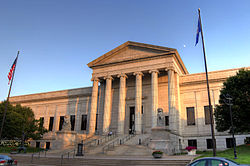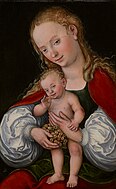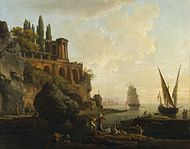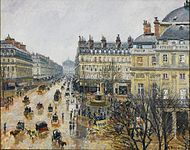Minneapolis Institute of Art: Difference between revisions
m →Outdoor exhibits: http→https for Google Books and Google News using AWB |
Rescuing 1 sources and tagging 0 as dead. #IABot (v1.2.7.1) |
||
| Line 20: | Line 20: | ||
The institute received gifts from Clinton Morrison and [[William Hood Dunwoody]], among others, for its building fund. In 1911, Morrison donated the land, formerly occupied by his family's Villa Rosa mansion, in memory of his father, [[Dorilus Morrison]], contingent on the institute's raising the {{dollarsign|US}}500,000 needed for the building. A few days later the institute received a letter from Dunwoody, who got the ball rolling: "Put me down for $100,000." A fundraising dinner a few days later brought in {{dollarsign|US}}335,500, donated in 90 minutes.<ref>{{cite web|title=Mia Stories|author=Gihring, Tim|url=http://new.artsmia.org/stories/once-at-mia-two-letters-that-built-a-museum/|publisher=Minneapolis Institute of Art|accessdate=August 18, 2015|date=January 1, 2015}}</ref> |
The institute received gifts from Clinton Morrison and [[William Hood Dunwoody]], among others, for its building fund. In 1911, Morrison donated the land, formerly occupied by his family's Villa Rosa mansion, in memory of his father, [[Dorilus Morrison]], contingent on the institute's raising the {{dollarsign|US}}500,000 needed for the building. A few days later the institute received a letter from Dunwoody, who got the ball rolling: "Put me down for $100,000." A fundraising dinner a few days later brought in {{dollarsign|US}}335,500, donated in 90 minutes.<ref>{{cite web|title=Mia Stories|author=Gihring, Tim|url=http://new.artsmia.org/stories/once-at-mia-two-letters-that-built-a-museum/|publisher=Minneapolis Institute of Art|accessdate=August 18, 2015|date=January 1, 2015}}</ref> |
||
The new museum, designed by the firm of [[McKim, Mead and White]], opened in 1915. The building came to be recognized as one of the finest examples of the [[Beaux-Arts architecture|Beaux-Arts]] [[architectural style]] in Minnesota. The art historian [[Bevis Hillier]] organized the exhibition ''[[Art Deco]]'' at the museum, presented from July to September 1971, which caused a resurgence of interest in this style of art. The building was originally meant to be the first of several sections, but only the front piece built. Several additions have subsequently been built according to other plans, including a 1974 addition by [[Kenzo Tange]]. An expansion designed by [[Michael Graves]] was completed in June 2006. Before the latest expansion, just 4 percent of the museum's nearly 100,000 objects could be on view at the same time; now that figure is 5 percent.<ref name="startribune.com">{{cite web |
The new museum, designed by the firm of [[McKim, Mead and White]], opened in 1915. The building came to be recognized as one of the finest examples of the [[Beaux-Arts architecture|Beaux-Arts]] [[architectural style]] in Minnesota. The art historian [[Bevis Hillier]] organized the exhibition ''[[Art Deco]]'' at the museum, presented from July to September 1971, which caused a resurgence of interest in this style of art. The building was originally meant to be the first of several sections, but only the front piece built. Several additions have subsequently been built according to other plans, including a 1974 addition by [[Kenzo Tange]]. An expansion designed by [[Michael Graves]] was completed in June 2006. Before the latest expansion, just 4 percent of the museum's nearly 100,000 objects could be on view at the same time; now that figure is 5 percent.<ref name="startribune.com">{{cite web|author=Tillotson, Kristin |date=June 9, 2006 |url=http://www.startribune.com/entertainment/stageandarts/11435636.html |title=Minneapolis Institute of Arts Opens New Wing |newspaper=Star Tribune |accessdate=August 18, 2016 |deadurl=yes |archiveurl=https://web.archive.org/web/20150403124548/http://www.startribune.com/entertainment/stageandarts/11435636.html |archivedate=April 3, 2015 |df= }}</ref><ref>{{cite web |url=http://www.mprnews.org/story/2006/06/07/miawing |title=Minneapolis Institute of Arts Opens New Wing |newspaper=Mprnews.org |date=June 7, 2006 |author=Wurzer, Cathy |accessdate=August 18, 2016}}</ref> [[Target Corporation]], for which the new wing is named, was the biggest donor, with a lead gift of more than $10 million.<ref name="startribune.com"/> |
||
In 2015 the institute rebranded itself, dropping the final "s" from its name, to become the Minneapolis Institute of Art and encouraging the use of the nickname Mia instead of the [[acronym]] MIA.<ref name=MPRname /><ref name=WhatsIn /> |
In 2015 the institute rebranded itself, dropping the final "s" from its name, to become the Minneapolis Institute of Art and encouraging the use of the nickname Mia instead of the [[acronym]] MIA.<ref name=MPRname /><ref name=WhatsIn /> |
||
Revision as of 19:38, 12 November 2016
 | |
 | |
| Lua error in Module:Location_map at line 526: Unable to find the specified location map definition: "Module:Location map/data/Minneapolis–Saint Paul" does not exist. | |
| Established | 1883 |
|---|---|
| Location | 2400 Third Avenue South Minneapolis, Minnesota |
| Coordinates | 44°57′31″N 93°16′27″W / 44.95861°N 93.27417°W |
| Director | Kaywin Feldman |
| Website | artsmia.org |
The Minneapolis Institute of Art (Mia), formerly known as the Minneapolis Institute of Arts,[1][2] is a fine art museum located in the Whittier neighborhood of Minneapolis, Minnesota, on a campus that covers nearly 8 acres (32,000 m²), formerly Morrison Park. As a major, government-funded public museum, the Institute does not charge an entrance fee, except for special exhibitions, and allows photography of its permanent collection for personal or scholarly use only. The museum receives support from the Park Board Museum Fund, levied by the Hennepin County commissioners. Additional funding is provided by corporate sponsors and museum members.[3] It is one of the largest art museums in the United States.
History

The Minneapolis Society of Fine Arts was established in 1883 to bring the arts into the life of the community. This group, made up of business and professional leaders, organized art exhibits throughout the decade. In 1889, the Society, now known as the Minneapolis Institute of Art, moved into its first permanent space, inside the newly built Minneapolis Public Library.
The institute received gifts from Clinton Morrison and William Hood Dunwoody, among others, for its building fund. In 1911, Morrison donated the land, formerly occupied by his family's Villa Rosa mansion, in memory of his father, Dorilus Morrison, contingent on the institute's raising the $500,000 needed for the building. A few days later the institute received a letter from Dunwoody, who got the ball rolling: "Put me down for $100,000." A fundraising dinner a few days later brought in $335,500, donated in 90 minutes.[5]
The new museum, designed by the firm of McKim, Mead and White, opened in 1915. The building came to be recognized as one of the finest examples of the Beaux-Arts architectural style in Minnesota. The art historian Bevis Hillier organized the exhibition Art Deco at the museum, presented from July to September 1971, which caused a resurgence of interest in this style of art. The building was originally meant to be the first of several sections, but only the front piece built. Several additions have subsequently been built according to other plans, including a 1974 addition by Kenzo Tange. An expansion designed by Michael Graves was completed in June 2006. Before the latest expansion, just 4 percent of the museum's nearly 100,000 objects could be on view at the same time; now that figure is 5 percent.[6][7] Target Corporation, for which the new wing is named, was the biggest donor, with a lead gift of more than $10 million.[6]
In 2015 the institute rebranded itself, dropping the final "s" from its name, to become the Minneapolis Institute of Art and encouraging the use of the nickname Mia instead of the acronym MIA.[1][2]
Collections



The museum features an encyclopedic collection of approximately 80,000 objects[8] spanning 5,000 years of world history. Its collection includes paintings, photographs, prints & drawings, textiles, architecture, and decorative arts. There are collections of African art, art from Oceania and the Americas, and an especially strong collection of Asian art, called "one of the finest and most comprehensive Asian art collections in the country".[9] The Asian collection includes Chinese architecture, jades,[10] bronzes, and ceramics.[9]
The institute owns the Purcell-Cutts House, just east of Lake of the Isles. The house was designed by Purcell & Elmslie and is a masterpiece of Prairie School architecture. It was donated to the museum by Anson B. Cutts Jr., the son of its second owner. The house is available for tours on the second weekend of each month.[11][12]
Services
In order to encourage private collecting and assist in the acquisition of important works of art, the museum has created "affinity groups" aligned with the seven curatorial areas of the museum. The groups schedule lectures, symposia, and travel for members.
The museum features a regular series of exhibitions that bring in traveling collections from other museums for display. Local business partners fund many of these exhibitions, and some feature the artists leading public tours through the exhibition.
The museum houses the Minnesota Artists Exhibition Program, an artist-controlled program devoted to the exhibition of works by artists who live in Minnesota.[13]
Funding
The William Hood Dunwoody Fund, endowed with one million dollars when Dunwoody died in 1914, has been used to purchase thousands of works.[14] Bruce Dayton, a life trustee of the institute since 1942, insisted that money raised in the $100 million fund-raising campaign for the Target wing, which opened in 2006, be split evenly between the building and the acquisitions endowment. That fund, now at $91 million, has allowed the institute to buy a rare early 18th-century Native American painted buckskin shirt and a nine-foot-long topographical View of Venice made by Jacopo de' Barbari in 1500, among other recent purchases.[15] In 2009, the value of the museum's $145 million endowment had fallen 21 percent from January 2008. The endowment typically provides nearly one-fifth of operating revenues. Contributions from individuals, corporations and foundations account for a quarter of revenues,[16] Almost half of the museum's operating money comes from the "park-museum fund," a century-old Hennepin County tax dating to 1911 that provides public support in exchange for free admission. That fund, which has risen steadily in recent years, provided the museum $12.6 million in the fiscal year of 2010. In 2011, the museum's annual budget was at $24.6 million, and endowment income was a total $4.3 million.[17]
In August 2016, the institute announed a $6 million bequest to fund the Gale Asian Art Initiative, which is designed to highlight the museum's holdings in Asian art, estimated at 16,800 objects. The bequest was made by Alfred P. Gale, an heir to the Pillsbury flour fortune. The first exhibition of the initiative will be Ink Unbound: Paintings by Liu Dan. Liu Dan, a contemporary Chinese artist has been asked to create an ink painting based on a painting in the museum's collection. Dan chose St. Paul and St. Barnabas at Lystra, a 17th-century painting by the Dutch artist Willem de Poorter.[18]
Works of art
-
Lucas Cranach the Elder, Portrait of Moritz Buchner, 1518
-
Lucas Cranach the Elder, Anna Buchner, c. 1520
-
Master of the Embroidered Foliage, Virgin and Child in a Landscape, 1492–1498
-
Lucas Cranach the Elder, Madonna and Child with Grapes, c. 1537
-
Marie Louise Elisabeth, Vigée-Le Brun, Portrait de la comtesse Maria Theresia Bucquoi
-
Alexander Roslin, The Comtesse d'Egmont Pignatelli in Spanish Costume, 1763
-
Sir Joshua Reynolds, Mrs. Froude, née Phyllis Hurrell playing an English guitar
-
Sir Joshua Reynolds, The Countess of Strafford, 1745
-
Luis de Morales, Man of Sorrows, c. 1560
-
Bartolomé Esteban Murillo, the Penitent Magdalene, c. 1665
-
Gerard van Honthorst, The Denial of St Peter, 1622
-
El Greco, Cleansing of the Temple, 1571
-
Jacob Willemsz Delff, Allegory of the Four Elements, c. 1600
-
Jean Siméon Chardin, The Attributes of Art, 1766
-
François Clouet, The Bath of Diana, 1550s
-
Hendrick ter Brugghen, Card players, 1623
-
Frederic Leighton, Jonathan Token to David, c.1868
-
Édouard Manet, The Smoker 1866
-
Robert Koehler, Portrait of Alvina Roosen 1900
-
Claude Joseph Vernet Imaginary Landscape, Italian harbor scene, 1746
-
Vincent van Gogh, Olive Trees Saint-Rémy, November 1889
-
Paul Signac, Bénédiction des thoniers à Groix, 1923
-
Camille Pissarro, Place du Théâtre Français, Paris, Rain, 1898
-
Paul Gauguin, Under the Pandanus II, 1891
Outdoor exhibits
The institute has a number of exhibits outside the building.[19] A pair of Chinese lions sit on either side of the 24th Street entrance. They were a gift from Ella Pillsbury Crosby in 1998. Because a museum curator determined that it would be too difficult to export 18th-century statues, new ones were carved in China in the 18th century style.[20]
The bronze statue The Fighter of the Spirit, by Ernst Barlach stands near the 24th Street entrance. The statue shows a winged man holding a sword vertically, tip up, and standing on the back of a snarling beast. The statue was commissioned by the University of Kiel and was originally placed in front of its church (Holy Spirit Church). The statue did not fit with the ideals of the ruling National Socialist party; it was vandalized and condemned as degenerate art. As a resut, the statue was removed and cut into four pieces, in preparation for melting down. However, the pieces were hidden on a farm and didn't resurface until 1946. The statue was repaired and placed in front of the Church of St. Nicholas (the Holy Spirit Church having been destroyed during the war).[21][22] The institute acquired one copy in 1959; the other is placed in front of the Gethsemane Church in Berlin.[23][24]
The Chinese Garden, which can be seen from inside the café, contains Taihu stones. These stones are said to represent the mountains of the Buddhist and Taoist immortals.[19] The garden was a gift of Ruth and Bruce Dayton.[25]
Target Park, which sits behind the museum, contains several congemporary statues, including an untitled work in bronze (c. 1968) by Pietro Consagra, Samba in African granite (1993) by Richard Erdman, and L'arbre de vie in stainless steel and pigment (20th century), designed by Jean Willy Mestach and manufactured by Michael Chowen.[26] There is also a granite and steel pavilion entitled Labyrinth (1993 ) by John Willenbecher. There are wide lines cut into the steel roof of the pavilion so that when the viewer stands inside, the labyrinth can be viewed by looking up.[19][27]
To celebrate its 100th anniversary, the institute purchased a sculpture by the late Polish artist Igor Mitoraj (1944–2014). Eros Bendato Screpolato, 1999, is one of a series of bronze "bandaged heads" produced by Mitoraj. Similar Mitoraj sculptures can be found at other public sites, including Market Square in Krakow, Poland, and Citygarden in downtown St. Louis, Missouri.[28][29][30]
See also
Notes
- ^ a b "MIA reboots brand to become 'Mia'". Mprnews.org. August 10, 2015. Retrieved August 18, 2016.
- ^ a b Tim Gihring (August 3, 2015). "Once at Mia: What's in a name? — Minneapolis Institute of Art". New.artsmia.org. Retrieved August 18, 2016.
- ^ "Minneapolis Institute of Art". New.artsmia.org. Retrieved August 18, 2016.
- ^ "Rembrandt's Lucretias". National Gallery of Art via Internet Archive. Archived from the original on November 17, 2004. Retrieved 2007-01-15.
{{cite web}}: Cite has empty unknown parameter:|1=(help); Unknown parameter|deadurl=ignored (|url-status=suggested) (help) - ^ Gihring, Tim (January 1, 2015). "Mia Stories". Minneapolis Institute of Art. Retrieved August 18, 2015.
- ^ a b Tillotson, Kristin (June 9, 2006). "Minneapolis Institute of Arts Opens New Wing". Star Tribune. Archived from the original on April 3, 2015. Retrieved August 18, 2016.
{{cite web}}: Unknown parameter|deadurl=ignored (|url-status=suggested) (help) - ^ Wurzer, Cathy (June 7, 2006). "Minneapolis Institute of Arts Opens New Wing". Mprnews.org. Retrieved August 18, 2016.
- ^ "William M. Griswold Appointed New Director of the Minneapolis Intitute of Arts". Retrieved 2007-07-24.
- ^ a b "New and Improved: The Minneapolis Institute of Arts Reopens". Antiques and the Arts Online. Retrieved 2007-09-04.
- ^ Among these is a 1784 piece believed to be the largest historic jade sculpture outside of China. "Jade Mountain Illustrating the Gathering of Poets at the Lan T'ing Pavilion". Art de l'Asie. www.framemuseums.org. Retrieved 2007-09-04.
- ^ "Purcell–Cutts House". Collections.artsmia.org. Retrieved August 18, 2016.
- ^ "Unified Vision: The Architecture and Design of the Prairie School > The Purcell-Cutts Tour". Archive.artsmia.org. Retrieved August 18, 2016.
- ^ "The Minnesota Artists Exhibition Program (MAEP)". artsmia.org. Retrieved August 18, 2016.
- ^ "This fund can only be used for the purchase of works of art." Handbook of the Minneapolis Institute of Arts. Minneapolis Institute of Art via Google Books. 1922. p. viii. Retrieved August 16, 2015.
- ^ Dobrzynski, Judith H. (March 14, 2012). "A Fund for Buying Art Burnishes Collections and Reputations". New York Times. Retrieved August 18, 2016.
- ^ Abbe, Mary (March 5, 2009). "MIA Cuts Staff, Programming". Startribune.com. Retrieved August 18, 2016.
- ^ Abbe, Mary (April 20, 2011). "Minneapolis Institute of Arts Cuts Jobs to Salvage Budget". Startribune.com. Retrieved August 18, 2016.
- ^ Abbe, Mary (August 18, 2016). "Minneapolis Institute of Art Gets $6 Million for "Gale Asian Art Initiative"". Startribune.com. Retrieved August 18, 2016.
- ^ a b c Mault, Coco (October 24, 2011). "A Look at MIA's Outdoor Art". Minnesota.cbslocal.com. Retrieved August 18, 2016.
- ^ Gehrz, Jim; Abbe, Mary (December 29, 2012). "Ella Pillsbury Crosby: Museum Lioness". Startribune.com. Retrieved August 18, 2016.
{{cite web}}: CS1 maint: multiple names: authors list (link) - ^ Paret, Peter; Helga Thieme (30 April 2012). Myth and Modernity: Barlach's Drawings on the Nibelungen. Berghahn Books. pp. 45–47. ISBN 978-0-85745-346-4.
- ^ "Erinnerungstag 19. Juni 1954: Geistkämpfer von Ernst Barlach vor der Nikolaikirche enthüllt". kiel.de. Retrieved August 19, 2016.
{{cite web}}: Cite has empty unknown parameter:|1=(help)Template:De icon - ^ "The Fighter of the Spirit, Ernst Barlach". Collections.artsmia.org. Retrieved August 19, 2016.
- ^ "Gethsemanekirche: Prenzlauer Berg". Berlin1.de. Retrieved August 19, 2016.Template:De icon
- ^ "Chinese Rock Garden, China". Collections.artsmia.org. Retrieved August 18, 2016.
- ^ "You searched for target park — Minneapolis Institute of Art". New.artsmia.org. Retrieved August 18, 2016.
- ^ "Labyrinth, John Willenbecher". Collections.artsmia.org. Retrieved August 18, 2016.
- ^ "Eros Bendato". inyourpocket.com. Retrieved August 18, 2016.
- ^ Uren, Adam (April 28, 2015). "The Big, Bronze Head Worth $1M: Meet Minneapolis Museum's Newest Attraction". Bringmethenews.com. Retrieved August 18, 2016.
- ^ "Gateway Foundation". Gateway-foundation.org. Retrieved August 18, 2016.
External links
- Official website
- Hennepin History Museum
- Johnson, Craig. "The Minneapolis Institute of Art". Myarmoury.com. Retrieved August 18, 2016.
- Minneapolis Institute of Art site at Google Arts & Culture
- Arts organizations in Minneapolis
- Culture of Minneapolis
- Museums in Minneapolis
- McKim, Mead, and White buildings
- Michael Graves buildings
- Art museums in Minnesota
- Beaux-Arts architecture in Minnesota
- FRAME Museums
- Art museums established in 1883
- 1883 establishments in Minnesota
- Asian art museums in the United States
























